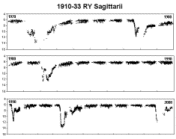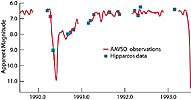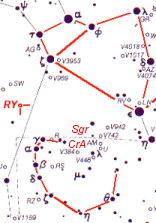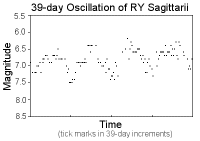Rebels With a Cause?
If there is a single word that one would use to describe the R Coronae Borealis (RCB) variable stars, it is enigmatic. This small, puzzling class of stars are most peculiar. With just under 50 known RCB stars, they appear to belong to an elite gang of rebellious variables. While we have been trained to think that activity of a star generally occurs as the star brightens, RCB stars prefer to do just the opposite. Choosing to spend the majority of their time at maximum brightness, this odd lot of variables are seen to be in an active phase as they fade to fainter magnitudes. In the seemingly backwards world of astronomy, where a smaller number implies a brighter stellar magnitude and a brighter star is generally indicative of activity, RCB variable stars seem to throw a wrench in the works of astronomical logic. It is an understatement then, to say that the RCB class of variable stars is unlike any other variable star grouping.
 |
| The fading in brightness observed in RCB stars is believed to be the result of a cloud of dust that periodically obscures the photosphere of the star. Animation courtesy of AAVSO member and observer, Michael Poxon. |
In general, RCB stars fade at sporadic intervals, during which time they are seen to decrease in brightness by 1 to 9 magnitudes. The episodes of reduced magnitude can last from several tens to several hundreds of days and are usually seen to return to the bright state in a time slower than the decline. While at maximum light, the RCB stars are observed to undergo small-scale, Cepheid-like variations with a fluctuation of several tenths of a magnitude and with periods of 20 to 100 days. Not only is the photometric behavior of the RCB stars peculiar, but they are unusual in the spectroscopic sense as well. The atmospheres of these luminous stars are poor in hydrogen, but reveal a rich abundance of carbon and helium. This lack of hydrogen implies that these stars have ceased the burning of hydrogen in the core. Spectra of the RCB stars at maximum reveals F or G supergiant.
The RCB class of variables is named for the bright prototype, R Coronae Borealis. (For a detailed look at R Coronae Borealis, see the January 2000 VSOTM.) While R CrB is the favored star of its type in the Northern Celestial Hemisphere, RY Sagittarii is viewed as its southern counterpart, being the second brightest star of its variable class. According to the AAVSO International database, RY Sgr is seen to vary between 6th and 14th magnitude, and as such, is a favorable target for many observers.
A Profile of RY Sagittarii
| Jacobus Cornelius Kapteyn (1851-1922) was a Dutch astronomer whose vital contributions to the field of astronomy are crucial to our current understanding of the Universe. The innovative astrophysicist was one of the first major supporters of the international collaboration of astronomers, cataloged nearly half a million stars Southern Hemisphere stars in the Annals of the Cape Observatory, performed the photographic determination of parallaxes of 10,000 stars, studied the proper motion of the stars which led to the discovery of "star streaming" (today viewed as evidence of the rotation of our galaxy), and constructed a model of the our galaxy known as "Kapteyn's Universe." |
Suspicion of RY Sgr's variable nature mounted in 1895 when J.C. Kapteyn remarked about the "fairly proved or at least highly probable" variability of the then unnamed star in the introduction to the Cape Photographic Durchmusterung. The stars behavior was examined and verified by Colonel E.E. Markwick of Gibraltar during his comparison of the Uranometria Argentina with the sky and was independently confirmed by Williamina Fleming of Harvard College Observatory(HCO) because of its peculiar spectrum and variability as seen on the HCO photographic plates. The confirmation as a variable was announced in the June 5, 1896 Harvard College Observatory Circular No. 7, by Edward C. Pickering in which he referred to RY Sgr as "a very remarkable object."
 |
| Click here for a look of the historical light curve of RY Sgr from 1895-1972, and on the above image for the light curve from 1970-2000. |
In 1972, Margaret Mayall (AAVSO Director 1956-1973) published the mean light curve of RY Sgr from 1892 to 1972 which accompanied her article "Variable Star Notes" published in the Royal Astronomical Society of Canada Journal. The historic light curve, which is seen on page 233 of this publication, was assembled in part by AAVSO's first recorder, Leon Campbell, from early photographic and visual observations, while the remainder of the light curve is by Margaret Mayall and is composed of observations made by AAVSO observers. The more recent plot to the right extends this light curve from 1970 to 2000. Since its induction into the AAVSO International Database in 1911, RY Sgr has been observed by hundreds of observers worldwide who have contributed over 27,000 data points.
A closer look at the light curve of RY Sgr reveals evidence of a secondary Cepheid-like variation during maximum light of about 39 days and with an amplitude of about half a magnitude. This finding was first announced by Luigi Jacchia in 1933 on the basis of his observations during the time frame of 1920-1932. More recent studies by teams such as Marraco and Milesi (1982) and Lawson and Cottrell (1990) suggest that the pulsation period of RY Sgr may in fact be shortening. In their 1990 paper, Lawson and Cottrell concluded that perhaps the pulsation period is slowly changing on a time-scale of about every 10 years. Such a period change is postulated to be the result of rapid evolution of the post-giant phase of the helium-enriched star or may be due to a substantial mass loss. Both hypothesis, however, imply that the lives of the RCB stars as pulsators is very short -- perhaps on the order of a millennium (Marraco and Milesi 1982). Continued observations will be vital in determining if the period is indeed shortening.
RCB Variable Stars: Behind the Scenes
What is the reason for the bizarre fading behavior associated with the RCB stars? The answer is not clearly defined, adding to the enigma associated with these objects. Theories suggest that the events may be attributed to the formation of dust or soot clouds around the star. Such a cloud could potentially shroud the star and obscure the photosphere. The clouds are theorized to be amorphous in shape, composed of carbon, occur at irregular intervals, and could possibly be the result of ejected material. (More detailed information about the dust-related theories may be found on the R Coronae Borealis VSOTM page.) The secondary cycle, however, may be due to semi-regular pulsation in outer layers of the star.
Adding to the mystery of the RCB stars is the unknown nature of their evolutionary history. At present, there are two major evolutionary models proposed to describe origin of RCB stars: (1) the Double Degenerate (DD) model or (2) the Final Helium Shell Flash (FF) model. Both theories involve the expansion of white dwarf stars to the supergiant phase. While the DD model implores the merging of the two white dwarf stars, the FF model assumes that the single white dwarf star expands to the supergiant stage by means of a final helium flash. Readers interested in learning more about the proposed evolution of the RCB stars are referred to the review paper by Geoffrey C. Clayton (1996) and the references therein.
Although much about this class of variable stars is largely not understood, their significance should not be understated. According to Clayton (1996), these stars are important because "first they represent a rare, or short-lived stage of stellar evolution, and second because these stars regularly produce large amounts of dust so they are laboratories for the study of dust formation and evolution."
RY Sagittarii (and friends) to the Rescue!
In addition to its visual following, RY Sgr has been observed by some of the most noted satellites of the day, including the International Ultraviolet Explorer (IUE), the Space Telescope Imaging Spectrograph (STIS) on the Hubble Space Telescope (HST), and with the HIgh Precision PARallax COllecting Satellite (HIPPARCOS or more commonly, Hipparcos), the latter of which will be the focus here.
On its 3 and a half year mission, Hipparcos collected the parallaxes and brightnesses of about 118,000 stars, including several thousand variable stars. To help researchers in their quest to observe variable stars, the extensive database of the AAVSO was utilized, serving several purposes. For one, AAVSO data helped Hipparcos scientists test their techniques developed to predict the activity of a given variable star. Predicting how a given light curve would progress and hence the projected magnitude of a variable star at a given time aided researchers in figuring out the exposure or integration time for observing a variable star. That is, the fainter the star, the longer Hipparcos had to keep a watchful eye on the object. The AAVSO data were also used to determine when a variable would be under the threshold limit for the satellite to observe the star (magnitude ~12.0). As continued support for the group, AAVSO observers around the world were asked to increase the monitoring of the select group of variables. During this time, Director Janet Mattei examined the incoming observations and notified the Hipparcos team of any modifications to the predictions.
 |
| The light curve of RY Sagittarii becomes more complete when Hipparcos data is superimposed with observations made by AAVSO observers. (Click on image for an enlarged view.) |
In addition, the AAVSO data were also used to check the Hipparcos photometry. Of special interest were the brightnesses of very red stars. When the Hipparcos and AAVSO data were compared, researchers found evidence of drifts in the Hipparcos photometry. The deviations, which turned out to be due to the aging optics of the satellite, lead to the recalibration of the optics, which in turn lead to more accurate photometry.
And last but not least, since the measurements of the variable stars were made somewhat sporadically, the AAVSO International Database was also used to fill in the gaps of Hipparcos light curves. The marriage of the light curves from the two sources resulted in the Volume 12 of the Hipparcos and Tycho Catalogues as the Hipparcos Variability Annex: Light Curves.
In all, the AAVSO supplied Hipparcos scientists with 20 years worth of digitized data consisting of more that one million observations for over 300 LPVs, with continued (virtually) real time support consisting of 70,000 observations, plus 75 years worth of times and magnitudes of maxima for many of the stars. As a result, 12,000 entries in the Hipparcos Catalogue are variables, with 8,200 previously unknown!
For more information about this phenomenal partnership, see the excerpted piece from the Sky & Telescope 1997 article.
More Moments in the Spotlight
The fadings of RY Sgr have been documented in many International Astronomical Union Circulars, as well as in numerous AAVSO Alert Notices and Newsflashes. These notices serve to alert the astronomical community of activity of this and other interesting variable stars, and to request observations to be used in conjunction with any special observing runs taking place.
The long-term light curve of RY Sgr has been published as an AAVSO Monograph. Available in two increments, AAVSO Monograph 5: RY Sagittarii 1892 - 1990 and Monograph 5, Supplement 1: RY Sagittarii 1991 - 1995 provides the light curves of RY Sgr for more than 100 years. In Monograph 5, RY Sgr has the honor of sharing its name with a terrific friend of the AAVSO, Dorrit Hoffleit, who is one of the most knowledgeable and accomplished women in astronomy, and to whom the publication is dedicated. The constellation of Sagittarius is said to be a favorite of Dorrit's. "It is one of the constellations on which she focused her attention and research during her 21 years of Directorship of the Maria Mitchell Observatory in Nantucket, Massachusetts. Dorrit and her over 100 summer students, mostly women, discovered many new variable stars in Sagittarius and determined their period and behavior."
Observers are welcome to subscribe to the free electronic publication of the AAVSO Alert Notice and Newsflash. The Monographs, however, are available for a small fee.
Observing RY Sagittarii
 |
| RY Sgr is fairly easy to locate in the southern skies, just SE of the bright star Ascella (zeta Sgr) and NE of gamma CrA . |
For those interested in adding the southern variable to their observing program, or for those who may want to reacquaint themselves with the old friend, the AAVSO has a finder chart to aid in identification of the field of RY Sgr. This chart is a wide field plot that shows mainly the constellations of Sagittarius and Scutum, with snippets of a few other constellations as well. RY Sgr is located in the constellation of Sagittarius, just a few degrees north of the boundary shared with Corona Australius. In fact, it can be found just between the handle of the tea kettle asterism in Sagittarius and the crown of Corona Australius. Once comfortable with the field, you may then use AAVSO VSP to make variable star charts to make estimates of the variable as it changes in brightness by 8 magnitudes.
RY Sgr can be seen throughout a good portion of the year to near-equatorial, equatorial, and southern observers. However, due to its proximity to the ecliptic, the star is unobservable during the months of December and January. During the months that it can be seen, observers should observe RY Sgr (and other RCB stars) once a week and should record the JD to 1 decimal place while the star is a maximum. PEP observers are encouraged to observe the star while at brightest light to monitor the small-scale variation seen at maximum. As the star fades, it is suggested to observe such stars every clear night, being sure to record the JD to 4 decimal places. Observations may then be submitted to the AAVSO, where they will be added to the 90-year database for the star.
With continued observations, perhaps one day the mystery of this and other RCB stars will soon unravel!
For More Information
- AAVSO finder chart for the constellation of Sagittarius
- AAVSO Monograph 5: RY Sagittarii 1892 - 1990
- Supplement 1: 1991 - 1995
- AAVSO Variable Star of the Month for January 2000: R Coronae Borealis
- Dick, J.S.B. and H.J. Walker. "Fadings of R Coronae Borealis Stars: Random or Chaotic?" Astronomy and Astrophysics, 252, 1991, 701-704.
- Clayton, Geoffrey C. "Invited Review Paper: The R Coronae Borealis Stars." Publications of the Astronomical Society of the Pacific, 108, 1996, 225-241.
- Holm, Albert V. "Observations of the Pulsation of RY Sgr." Journal of the AAVSO, 27, 1999, 113-117.
- Jacchia, L. 1933 Publications of dell'Osservatorio Astronomie de Bologna, 2, 173.
- Lawson, W.A. and P.L. Cottrell. "A Change in the Pulsation Period of the R Coronae Borealis Star RY Sgr." Monthly Notices of the Royal Astronomical Society, 242, 1990, 259-261.
- Mayall, Margaret W. "Variable Star Notes." Royal Astronomical Society of Canada Journal, 66, 1972, 233-235.
- Marraco, Hugo G. and Gerardo E. Milesi. "The Period Shortening of RY Sagittarii." The Astronomical Journal, 87, 1982, 1775-1782.
- Turon, Catherine. "From Hipparchos to Hipparcos: Measuring the Universe, One Star at a Time." Sky & Telescope, July 1997, 28-34. (See excerpt of article by Janet A. Mattei and Grant Foster, titled "Amateurs and the Hipparcos Mission.")
This month's Variable Star of the Month was prepared by Kerri Malatesta, AAVSO Technical Assistant.


